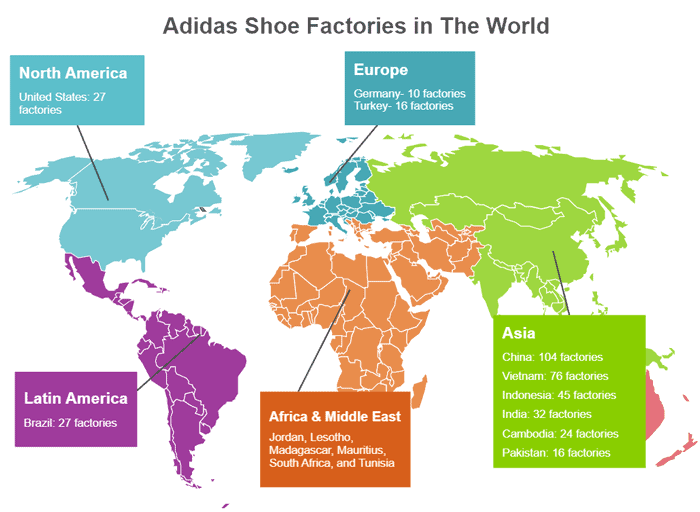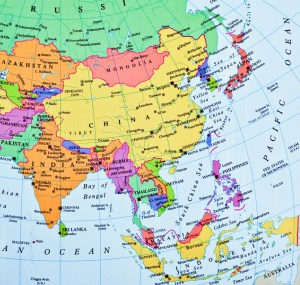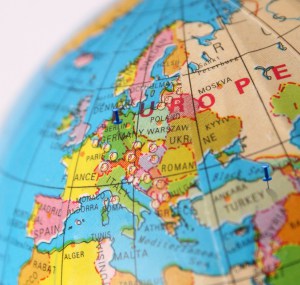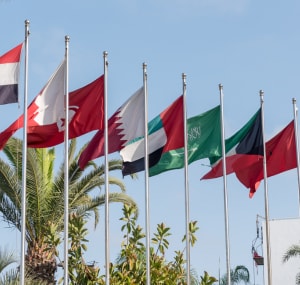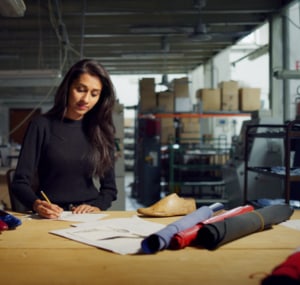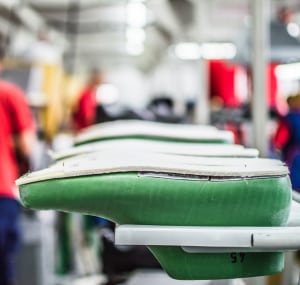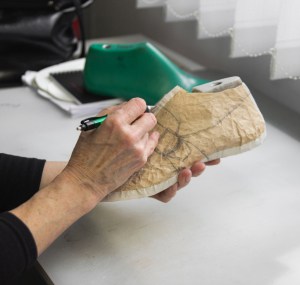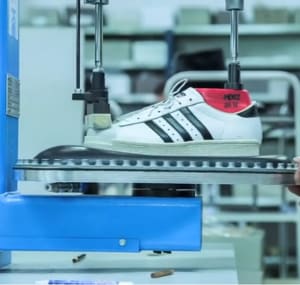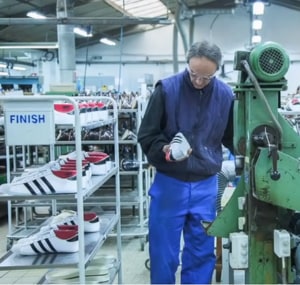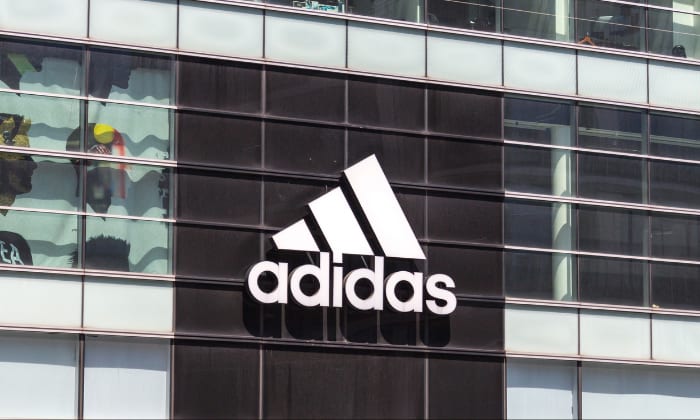Producing almost 419 million pairs of shoes every year, Adidas is clearly living up to its reputation as the second-biggest shoe manufacturer in the world, next to Nike. With their broad range of footwear, from sports to fashion-forward ones, one may be curious to know: where are Adidas shoes made?
Well, considering its global status, Adidas does not confine its production to a single country. It sources its shoes from different regions, such as Vietnam, China, and Indonesia, in order to cater to all of its consumers worldwide.
If you want to know the specific countries where Adidas products are made, you’ve come to the right place. Read more to find out!
Table of Contents
Background on Adidas
Adidas is the brainchild of Adolf “Adi” Dassler, who mastered the craft of shoemaking in his mother’s laundry area in Herzogenaurach, Germany. Together with his brother Rudolf, they registered their business as Gebrüder Dassler Schuhfabrik, which translates to Dassler Brothers Shoe Factory.
However, after World War II, the relationship of the two brothers soured due to a series of misunderstandings and disagreements, which led to their bitter estrangement. They decided to go their separate ways in 1948.
Adolf then founded Adidas shoe company. The brand name is a combination of Adi, his nickname, and Das, the first three letters of his surname. Adi used his experiences and innovatively fused practicality with style, thereby creating sports footwear that quickly gained popularity among athletes worldwide.
Rudolf, on the other hand, founded a rival company, initially named Ruda, derived similarly from the first two letters of his first and last names. However, he soon rebranded it to Puma.
From Germany to the World
Adidas cemented itself in the global spotlight during the 1954 World Cup, where it played a significant role in the unexpected victory of the German national football team against the Hungarians, who were believed to be unbeatable at that time.
Adi provided the German team with Adidas boots that featured removable screw-in studs. This feature allowed the players to adjust to the conditions of the field, thus, giving them an advantage over their opponent.
Because of the German team’s win, which was also dubbed “The Miracle of Bern”, Adidas design was recognized especially among athletes.
Since then, the Adidas industry has been expanding its reach globally, making it one of the most iconic brands in the world today. Adidas shoes are now being produced not just in its home country but in various parts of the globe, thanks to the multiple factory locations established over time.
Adidas Shoe Factory: Where Are Adidas Products Made?
Adidas has its global headquarters nestled in Herzogenaurach, Germany, a town that has the distinct honor of being the birthplace of this renowned brand.
Beyond its German roots, Adidas has spread its influence far and wide, boasting a multitude of satellite locations across the globe. As of now, the company has manufacturing plants in over 45 countries, with the majority being in Asia.
Locations:
1. Asia-Pacific:
The Asia-Pacific region has the largest number of Adidas manufacturing locations in the world. Here is the breakdown of Adidas factories in Asia that produce shoes.
- China- 104 factories
- Vietnam- 76 factories
- Indonesia- 45 factories
- India- 32 factories
- Cambodia- 24 factories
- Pakistan- 16 factories
In recent years, the company has switched its main outsourcing from China to Vietnam. As such, the latter has outpaced the former in terms of shoes produced.
Other countries in Asia where Adidas products are made include Bangladesh, Japan, Korea, the Philippines, and Taiwan. Thailand also has up to 13 Adidas factories; however, the country only produces apparel for the company.
2. Europe:
Europe, the birthplace of Adidas, maintains a substantial number of factories producing Adidas goods.
- Germany- 10 factories
- Turkey- 16 factories
Other warehouse locations are Austria, Belgium, the Czech Republic, Georgia, Greece, Hungary, Italy, Lithuania, Poland, Portugal, Romania, Russia, Slovenia, Spain, Ukraine, and the United Kingdom.
3. American continents:
The Americas region, both North and South, also contributes significantly to Adida’s production.
- United States (North America): 27 factories
- Brazil (South/Latin America): 27 factories
Other countries in the American continents where Adidas products are made include Argentina, Canada, Chile, Colombia, Costa Rica, El Salvador, Honduras, Mexico, and Nicaragua.
4. Africa and the Middle East:
While not as prominent, Adidas has also established manufacturing ties in the Middle East and Africa.
Countries in this region are Jordan, Lesotho, Madagascar, Mauritius, South Africa, and Tunisia.
Manufacturers of Each Type of Adidas Shoes
Additionally, different types of Adidas shoes are produced in different factories to cater to the specific design requirements:
- Golf Shoes
These specialized shoes, designed for comfort and grip on the golf course, are primarily manufactured in China, Indonesia, Vietnam, and Taiwan.
- Superstar Shoes
The Superstar line is one of Adidas’ iconic shoes. They are largely made in Indonesia, Vietnam, and China.
- Yeezy Shoes
The Yeezy shoes, also known as Yeezys, are a result of Adidas’ collaboration with American rapper, Kanye West. These are exclusively made in USA and China.
- Stan Smith Shoes
Another staple Adidas brand is the Stan Smith. This line, known for its clean, minimalistic design, is only manufactured in Germany, embodying the superior craftsmanship and quality that Germany shoes are renowned for.
- Tennis Shoes
Adidas produced the first leather tennis shoes, a concept developed by Horst Dassler, the son of Adi Dassler. They are made in Vietnam, China, and Indonesia.
- Ultraboost Shoes
Made in China, the Ultraboost shoes are part of Adidas’ running lineup, featuring responsive cushioning and energy return.
Adidas Production Process
The production of Adidas shoes is a meticulous process that blends traditional craftsmanship with modern technology, ensuring the delivery of products that truly embody the brand’s commitment to quality and innovation. Let’s take a closer look at its process.
1. Designing
A concept is drawn by a team of designers. These designs are then reviewed and refined until they align with the performance requirements and the aesthetic standards of the brand.
2. Pattern and mold making
Patterns are created for each component, serving as a blueprint for cutting materials. Simultaneously, a mold of the shoe, also known as a ‘last’, is produced, which will guide the assembly process.
3. Material selection and cutting
Adidas sources a variety of materials, including leather, synthetic fabrics, and rubber, which are then precisely cut into the required shapes as per the patterns.
4. Stitching and assembly
The cut pieces are then sewn together to form different parts of the shoe, including the upper part. These sections are assembled using the last to maintain the correct shape, and the sole is affixed to the upper during this stage.
5. Finishing and quality check
Once assembled, the shoes are cleaned, undergo final detailing, and then move to a rigorous inspection process to ensure they meet Adidas’ stringent quality standards. Once approved, they are packaged and ready for shipping.
Ethical and Sustainability Considerations
Incorporating innovation, Adidas factories have implemented automated facilities known as “Speedfactories” in Germany and the USA.
This is Adidas’ initiative to mitigate supply chain issues, reduce costs, increase efficiency, lessen environmental impact, and expedite the delivery of products to Western markets, which are considered to be the key market of Adidas.
After all, although sourcing labor from Asia is inexpensive, shipping the products of Adidas from Asian countries to other parts of the world is expensive and creates more carbon footprint.
Frequently Asked Questions
Does Adidas employ sweatshop workers and child workers?
Sweatshops are workplaces known for having a rough environment. In sweatshops, workers are often paid very little and not given any retirement and health benefits, despite working long hours. In some cases, children are also employed to work.
Given the massive scale of its production requirements, it’s unfortunate to note that Adidas, like many large corporations, has been linked with the use of sweatshops to fulfill its demanding manufacturing needs.
How can I tell if my Adidas shoes are original?
There are different ways to determine whether your Adidas shoes are original.
The “old” method is checking the country of manufacture. Back in the day, Adidas shoes manufactured in Germany are the ones considered to be original. However, considering that Adidas has long expanded its production across the globe, “original Adidas made in Germany” may no longer be the sole indicator of authenticity.
Here are some other ways to check your shoes’ authenticity:
- Check the serial number. Each pair has a unique 12-digit serial code that begins with “Germany” and ends with “MD”.
- Check the cut-outs to see if they are neatly attached.
- The logo should be a carving, not a sticker.
- The stitches should be vertical, strong, smooth, and clean, and without glue residue.
- Check if there’s a barcode on the sole.
- Check the SKU code on the internet. An SKU code is designated for each shoe model and design.
Which countries produce the most number of Adidas shoes?
China and Vietnam stand out as the primary manufacturing hubs for Adidas shoes, given that these countries host the largest number of Adidas factories globally. Their high production capacity allows them to meet the vast demand for Adidas products worldwide.
The importance of knowing where Adidas shoes are made?
Knowing where Adidas shoes are manufactured may make it easier for you to spot a genuine pair. For instance, as Thailand doesn’t produce footwear for the company, Thailand-made Adidas kicks will certainly seem suspicious.
It would also help to reduce the carbon footprint to support Adidas shoes made in your own country (or one nearby). And if you’re concerned with ethical issues, it may weigh less on your conscience to know that your kicks are unlikely to be produced in sweatshops, such as those in China and Vietnam.
How long does it take to make a pair of Adidas shoes?
As Adidas has high standards for material and production quality, the entire process of manufacturing component parts and assembling can take up to 60 days.
Does Adidas have any plans to expand their factory locations?
As far as we know, Adidas is investing in Speedfactories, something that can replace sweatshops and manual labor. One clear proof of this is how the company has closed down factories in countries that have this state-of-the-art technology. As of now, Adidas is now planning to move its Speedfactories to Asia as well.
Conclusion:
Knowing the answer to, “where are Adidas shoes made?” offers insight into the remarkable journey of Adidas. From its humble beginnings in a modest laundry room, it became an iconic, global titan in shoe manufacturing.
It is an example that diverse and high-quality products, innovative spirit, and resiliency not only result in success but also lead to global influence.
So the next time you slip into your Adidas shoes, realize that each step you take is a testament to the hard work of numerous factory workers worldwide, and how you are a part of this inspiring global story.

Veronica is our content editor. She is a talent in delivery. Her main work is editing and writing articles that are both informative and simple to follow. She is in charge of synthesizing our understanding of what personal protection equipment (PPE) is needed in each job, how to best apply it, and how to visualize that equipment.





